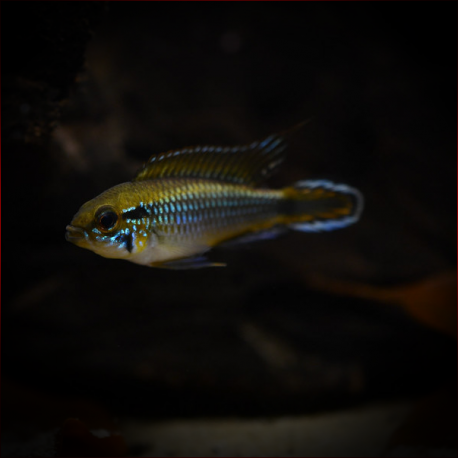More info
Datasheet
| Minimum Tank Size | 60 litres / 15.85 US gallons |
| Maximum Size | 7.5cm / 2.95inches |
| Temperature | 22°C / 71.60°F - 29°C / 84.20°F |
| Hardness | 0.00dgH / 0ppm - 10.03dgH / 179ppm |
| pH | 3.5-7.0 |
General Description
The Apistogramma Agassizii, commonly known as Agassizi's Dwarf Cichlid, belongs to the family Cichlidae and is classified under Perciformes. Selectively bred for the aquarium trade, this species has numerous ornamental forms. With a maximum size of 7.5cm, it is one of the most speciose South American cichlid genera, with approximately 70 valid species to date.
Aquarium Setup
For an aquarium housing Agassizi's Dwarf Cichlid, a minimum tank size of 60 litres is recommended. The setup should include plenty of cover and structure for the fish to explore. Adding items like ceramic flowerpots, plastic piping, wood roots, and branches can provide hiding spots and mimic their natural habitat. A sandy substrate with dried leaf litter enhances the environment, promotes microbe growth, and acts as a food source for fry. Maintaining dim lighting and incorporating plant species like Microsorum, Taxiphyllum, Cryptocoryne, and Anubias is ideal. Water parameters should be kept at a pH range of 3.5-7.0, hardness of 0-179ppm, and a temperature of 22-29°C.
Behaviour
Captive-raised Agassizi's Dwarf Cichlids are recommended for community aquariums, while wild specimens are best kept alone or with small dither fishes like Nannostomus spp. These cichlids should ideally not be mixed with other Apistogramma species. Additionally, females of this species can exhibit hyper-aggressive behavior towards males post-spawning.
Feeding and Diet
Primarily carnivorous, Agassizi's Dwarf Cichlid feeds on benthic invertebrates in its natural habitat. In the aquarium, providing live and frozen foods such as Artemia, Daphnia, and chironomid larvae is essential. While they can adapt to dried food, pelleted products are generally preferred over flakes.
Reproduction & Dimorphism
During reproduction, this species favors softer, more acidic water conditions. They are substrate spawners, with females laying eggs in crevices among the decor. Females take on the responsibility of caring for the eggs and fry, sometimes exhibiting hyper-aggressive behavior towards males in smaller aquariums. Males are larger, more colorful, and develop extended fins compared to females.
Habitat and Distribution
Agassizi's Dwarf Cichlid is commonly found in slower-moving tributaries, backwaters, and creeks with fallen leaf litter in the Amazon/Solimões basin. Their distribution ranges from the upper Río Ucayali in Peru to the eastern limit represented by the Capim River in Brazil's Amazon delta region. The species displays variation in body coloration and patterning based on locality.

